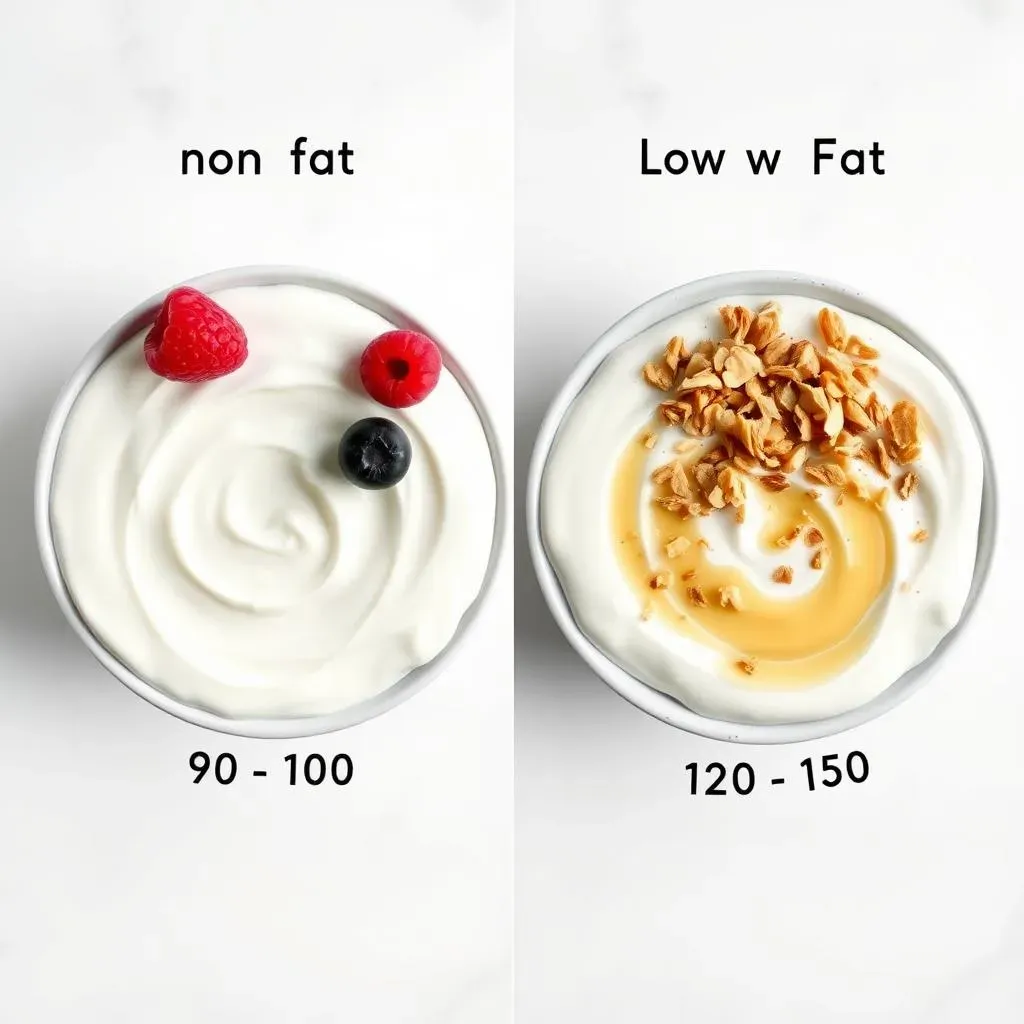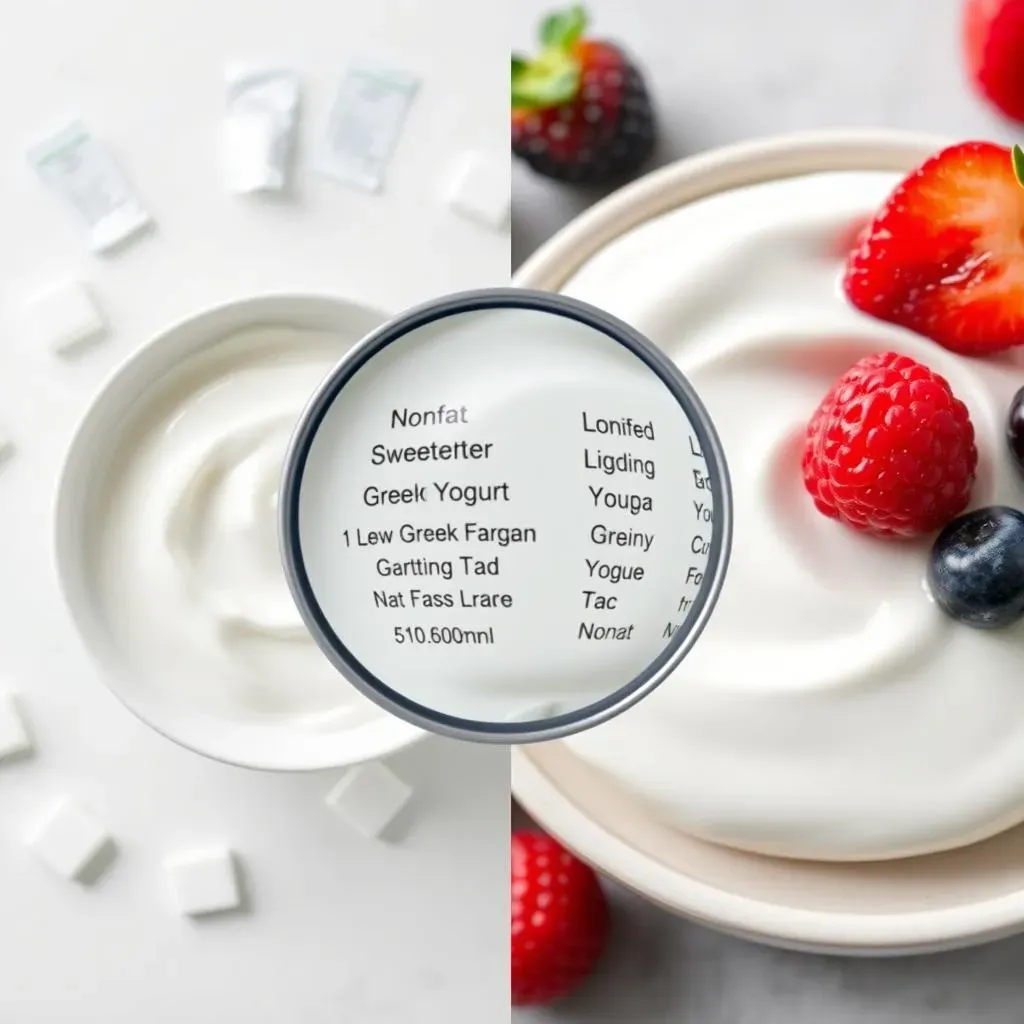Table of Contents
Greek yogurt has soared in popularity, celebrated for its creamy texture, high protein content, and versatility. But when you stroll down the dairy aisle, you're faced with a choice: low fat vs nonfat Greek yogurt. Which one do you pick? Are you team low fat, swayed by the calorie count? Or are you team nonfat, prioritizing minimal fat intake? The decision isn't always straightforward. This article dives deep into the nutritional nuances, taste profiles, and health benefits of both low fat vs nonfat Greek yogurt to help you make an informed decision.
Nutritional Showdown: Low Fat vs Nonfat Greek Yogurt

Nutritional Showdown: Low Fat vs Nonfat Greek Yogurt
Alright, let's get down to the nitty-gritty: the nutritional differences between low fat and nonfat Greek yogurt. This is where things get interesting! Both are nutritional powerhouses, packed with protein, calcium, and probiotics, but the fat content is the key differentiator. A typical 6-ounce (170g) serving of nonfat Greek yogurt clocks in around 90-100 calories, with virtually no fat (less than 0.5g). On the other hand, low fat Greek yogurt of the same serving size usually has around 120-150 calories, with about 2-5g of fat. So, if you're strictly counting calories, nonfat has a slight edge. But hold on, there's more to the story than just calories.
The fat content impacts more than just the calorie count. It also influences the texture and how your body absorbs certain nutrients. Fat-soluble vitamins like A, D, E, and K need fat to be properly absorbed. While Greek yogurt isn't a primary source of these vitamins, the presence of some fat can aid in their absorption from other foods you eat alongside it. Also, that little bit of fat can contribute to satiety, helping you feel fuller for longer. It's a trade-off – fewer calories with nonfat, or potentially better nutrient absorption and more satisfaction with low fat. What's more important to you?
Nutrient | Nonfat Greek Yogurt (6oz) | Low Fat Greek Yogurt (6oz) |
|---|---|---|
Calories | 90-100 | 120-150 |
Fat | 0-0.5g | 2-5g |
Protein | 15-20g | 15-20g |
Calcium | ~15% DV | ~15% DV |
Now, before you jump to conclusions, let's talk about protein. Both low fat and nonfat Greek yogurt boast impressive protein levels, typically around 15-20 grams per serving. This is a huge win for anyone looking to build muscle, manage hunger, or simply boost their protein intake. The protein content remains relatively consistent regardless of the fat content, making Greek yogurt a fantastic protein source regardless of which version you choose. It's all about finding the right balance for your individual needs and preferences. Don't get too caught up in the numbers – consider the bigger picture of your overall diet and lifestyle.
Decoding the Differences: Taste, Texture, and Additives in Low Fat vs Nonfat Greek Yogurt

Decoding the Differences: Taste, Texture, and Additives in Low Fat vs Nonfat Greek Yogurt
Taste and Texture: A Sensory Experience
Alright, let's talk about the fun stuff: taste and texture! This is where personal preference really comes into play. Nonfat Greek yogurt tends to have a tangier, slightly more acidic flavor compared to its low fat counterpart. The absence of fat can make the texture a bit thinner and sometimes even a little chalky. Some people enjoy that sharp, clean taste, while others find it a bit too intense on its own.
Low fat Greek yogurt, on the other hand, boasts a richer, creamier texture thanks to the presence of a small amount of fat. This fat also mellows out the tangy flavor, making it a bit more palatable for some. Think of it like the difference between skim milk and whole milk – both are milk, but the mouthfeel and flavor are distinctly different. It's all about what your taste buds crave! Do you prefer a bold, tangy bite or a smoother, more subtle experience?
The Additive Question: What's Really in Your Yogurt?
Now, let's address the elephant in the room: additives. Sometimes, to compensate for the lack of fat in nonfat Greek yogurt, manufacturers add thickeners, stabilizers, or even sweeteners to improve the texture and flavor. These can range from natural ingredients like pectin or guar gum to artificial sweeteners like aspartame or sucralose. It's crucial to read the ingredient list carefully to know exactly what you're putting into your body. Are you okay with a few added ingredients for a better texture, or do you prefer a simpler, more natural product?
Low fat Greek yogurt is less likely to contain these additives, as the fat naturally contributes to a more desirable texture and flavor. However, it's still important to check the label. Some brands might add sugar or other ingredients to enhance the taste. The key takeaway here is to be a conscious consumer. Don't just grab the first container you see – take a moment to read the ingredient list and make an informed decision based on your personal preferences and dietary needs. Knowledge is power, especially when it comes to food!
Factor | Nonfat Greek Yogurt | Low Fat Greek Yogurt |
|---|---|---|
Taste | Tangier, more acidic | Milder, creamier |
Texture | Thinner, potentially chalky | Richer, smoother |
Additives | More likely to contain thickeners, stabilizers, or sweeteners | Less likely to contain additives |
Health Benefits of Greek Yogurt: Beyond Low Fat and Nonfat Options

Health Benefits of Greek Yogurt: Beyond Low Fat and Nonfat Options
Packed with Protein: Fuel for Your Body
Let's be real, the protein punch in Greek yogurt is a major win, no matter if you're choosing low fat or nonfat. We're talking about roughly 15-20 grams per serving! That's a significant amount of protein that can seriously benefit your body. Protein is crucial for building and repairing tissues, making enzymes and hormones, and supporting a healthy immune system. It also plays a vital role in weight management by increasing satiety and helping you feel fuller for longer. Whether you're a fitness fanatic or just trying to make healthier choices, Greek yogurt is a fantastic way to boost your protein intake.
And it's not just about the quantity of protein, but also the quality. Greek yogurt contains all nine essential amino acids, making it a complete protein source. These amino acids are the building blocks of protein and are essential because your body can't produce them on its own – you need to get them from food. So, by enjoying a serving of Greek yogurt, you're not only getting a hefty dose of protein, but also ensuring that you're providing your body with all the necessary amino acids to function optimally. Talk about a nutritional powerhouse!
Gut Health and Beyond: The Power of Probiotics
let's dive into the world of probiotics! Greek yogurt is a fermented food, which means it contains live and active cultures, also known as probiotics. These beneficial bacteria play a crucial role in maintaining a healthy gut microbiome. A balanced gut microbiome is essential for optimal digestion, nutrient absorption, and immune function. Probiotics can help improve digestion by breaking down food and reducing bloating and gas. They can also strengthen your immune system by stimulating the production of antibodies and fighting off harmful bacteria.
But the benefits of probiotics extend far beyond just gut health. Research suggests that a healthy gut microbiome can also impact your mental health, skin health, and even your weight. The gut-brain axis is a fascinating area of research that explores the connection between the gut and the brain. Studies have shown that probiotics can help reduce symptoms of anxiety and depression. And when it comes to skin health, probiotics can help reduce inflammation and improve skin conditions like acne and eczema. So, by incorporating Greek yogurt into your diet, you're not just nourishing your body, but also supporting a healthy and happy gut, which can have a ripple effect on your overall well-being.
Benefit | Description |
|---|---|
Muscle Building and Repair | High protein content aids in muscle growth and recovery. |
Weight Management | Protein promotes satiety, helping control appetite. |
Digestive Health | Probiotics support a healthy gut microbiome. |
Immune Support | Probiotics can strengthen the immune system. |
Making the Right Choice: Low Fat vs Nonfat Greek Yogurt for Your Goals

Making the Right Choice: Low Fat vs Nonfat Greek Yogurt for Your Goals
so you've got the nutritional lowdown and the taste test notes. Now it's time to figure out which Greek yogurt is your perfect match! The truth is, there's no one-size-fits-all answer when it comes to low fat vs nonfat Greek yogurt. The best choice really depends on your individual goals, dietary needs, and personal preferences. Are you trying to shed a few pounds? Build muscle? Or just maintain a healthy lifestyle? Let's break it down.
If weight management is your primary goal, nonfat Greek yogurt might be your go-to. With its lower calorie count, you can enjoy a satisfying snack or meal without derailing your progress. Plus, the high protein content will help keep you feeling full and prevent those pesky cravings. However, don't completely demonize fat! A little bit of healthy fat can actually aid in weight loss by promoting satiety and improving nutrient absorption. So, if you find that nonfat yogurt leaves you feeling hungry shortly after, low fat might be a better option to keep you satisfied and on track.
For those focused on building muscle and maximizing protein intake, both low fat vs nonfat Greek yogurt are excellent choices. The protein content is virtually the same, so it really comes down to personal preference. If you're following a strict low-fat diet, nonfat is the obvious choice. But if you're not afraid of a little healthy fat, low fat can provide a slightly richer flavor and texture, making it more enjoyable to eat regularly. Consider your overall calorie and macronutrient goals when making your decision.
And finally, if you're simply looking for a healthy and nutritious snack or meal option, both low fat vs nonfat Greek yogurt are great choices. It's all about finding the one that you enjoy the most and that fits into your lifestyle. Experiment with different brands and flavors to discover your favorites. Add some fruit, nuts, or granola for extra flavor and nutrients. The possibilities are endless! The most important thing is to make Greek yogurt a regular part of your diet and enjoy all the amazing health benefits it has to offer.
Goal | Recommended Choice | Reasoning |
|---|---|---|
Weight Loss | Nonfat (or Low Fat in moderation) | Lower calorie count, high protein for satiety. |
Muscle Building | Either Low Fat or Nonfat | Similar protein content, choose based on taste and fat preference. |
General Health | Either Low Fat or Nonfat | Both are nutritious, choose based on taste and lifestyle. |
Creative Culinary Uses: Incorporating Low Fat or Nonfat Greek Yogurt Into Your Diet

Creative Culinary Uses: Incorporating Low Fat or Nonfat Greek Yogurt Into Your Diet
so you've picked your perfect Greek yogurt – now what? It's time to unleash your inner culinary artist and discover the endless possibilities of incorporating low fat or nonfat Greek yogurt into your diet! Forget those boring spoonfuls straight from the container (unless that's your thing, no judgment!). Greek yogurt is a chameleon in the kitchen, adapting to both sweet and savory dishes with ease. We're talking everything from breakfast parfaits and smoothies to creamy dips and even healthy baking swaps. Get ready to be amazed by the versatility of this humble dairy product!
Let's start with breakfast, the most important meal of the day! Greek yogurt is a fantastic base for a healthy and satisfying breakfast parfait. Layer it with your favorite fruits, granola, and a drizzle of honey for a delicious and nutritious start to your day. Or, blend it into a smoothie for a creamy and protein-packed boost. Add some berries, spinach, and a scoop of protein powder for a supercharged smoothie that will keep you feeling full and energized for hours. And don't forget about overnight oats! Mix Greek yogurt with rolled oats, milk, and your favorite toppings, and let it sit in the fridge overnight for a grab-and-go breakfast that's both healthy and delicious.
But the culinary adventures don't stop at breakfast! Greek yogurt can also be used in a variety of savory dishes. Use it as a healthier alternative to sour cream or mayonnaise in dips, sauces, and dressings. It adds a creamy tang without all the extra fat and calories. Or, use it as a marinade for chicken or fish to tenderize the meat and add a delicious flavor. And for all you bakers out there, Greek yogurt can be used as a substitute for butter or oil in many recipes. It adds moisture and protein while reducing the fat content. From cakes and muffins to cookies and brownies, the possibilities are endless! So, ditch the guilt and indulge in your favorite treats with a healthy Greek yogurt twist.
Culinary Use | Description | Benefits |
|---|---|---|
Breakfast Parfait | Layer Greek yogurt with fruit, granola, and honey. | Healthy, satisfying, and customizable. |
Smoothie Booster | Blend Greek yogurt with fruits, vegetables, and protein powder. | Creamy, protein-packed, and nutrient-rich. |
Healthy Dip | Substitute Greek yogurt for sour cream or mayonnaise. | Lower in fat and calories, adds a tangy flavor. |
Baking Substitute | Use Greek yogurt in place of butter or oil. | Adds moisture and protein, reduces fat content. |
Final Verdict: Choosing the Right Greek Yogurt for You
Ultimately, the "best" choice between low fat vs nonfat Greek yogurt depends on your individual dietary needs, preferences, and health goals. If you're strictly monitoring calorie intake or trying to minimize fat consumption, nonfat Greek yogurt is a solid option. However, if you prefer a richer taste and don't mind the extra calories and saturated fat (which, in moderation, can be part of a healthy diet), low fat Greek yogurt could be more satisfying. Regardless of which you choose, both options offer a significant protein boost and a range of essential nutrients, making them a smart addition to a balanced diet. Experiment with different brands and flavors to find your perfect Greek yogurt match!
